
A cardinal is a senior member of the clergy of the Catholic Church. Cardinals are created by the pope and typically hold the title for life. Collectively, they constitute the College of Cardinals.
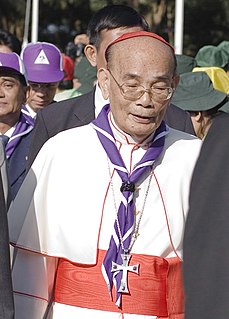
Michael Michai Kitbunchu is a Thai prelate of the Roman Catholic Church. He served as Archbishop of Bangkok from 1973 to 2009 and was elevated to the cardinalate in 1983. He has been the Protopriest of the College of Cardinals since 14 December 2016.
In pectore is a term used in the Catholic Church for an action, decision, or document which is meant to be kept secret. It is most often used when there is a papal appointment to the College of Cardinals without a public announcement of the name of that cardinal. The pope reserves that name to himself. The Italian language version of the phrase – in petto – is sometimes used. When the name of a new cardinal is announced or made public, it is sometimes said to be published.

Papal inauguration is a liturgical service of the Catholic Church within Mass celebrated in the Roman Rite but with elements of Byzantine Rite for the ecclesiastical investiture of a pope. Since the inauguration of Pope John Paul I, it has not included the 820-year-old (1143–1963) papal coronation ceremony.

Paulo Evaristo Arns OFM was a Brazilian prelate of the Catholic Church, who was made a cardinal and the Archbishop of São Paulo by Pope Paul VI, and later became cardinal protopriest. His ministry began with a twenty-year academic career, but when charged with responsibility for the Sao Paulo Archdiocese he proved a relentless opponent of Brazil's military dictatorship and its use of torture as well as an advocate for the poor and a vocal defender of liberation theology. In his later years he openly criticized the way Pope John Paul II governed the Catholic Church through the Roman Curia and questioned his teaching on priestly celibacy and other issues.

The 1534 papal conclave was convened after the death of Pope Clement VII, and elected as his successor Cardinal Alessandro Farnese, who became Pope Paul III.

The 1342 papal conclave – the papal conclave convened after the death of Pope Benedict XII, it elected Cardinal Pierre Roger, who became the fourth Pope of the period of Avignon Papacy under the name Clement VI.
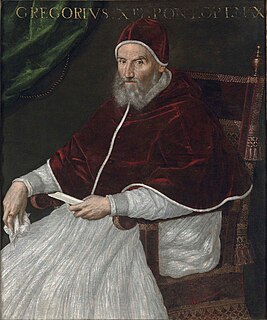
The 1572 papal conclave, convoked after the death of Pope Pius V, elected Cardinal Ugo Boncompagni, who took the name Gregory XIII.
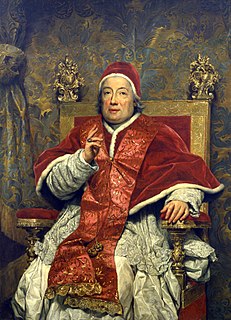
The 1758 papal conclave, convoked after the death of Pope Benedict XIV, elected Cardinal Carlo Rezzonico of Venice, who took the name Clement XIII.

The 1774–75 papal conclave, was convoked after the death of Pope Clement XIV and ended with the election of Cardinal Giovanni Angelo Braschi, who took the name of Pius VI.
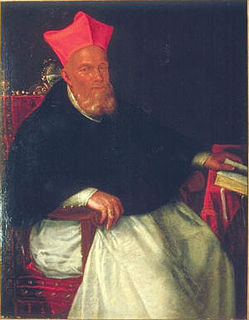
Girolamo Cardinal Bernerio, O.P. was an Italian Cardinal of the Roman Catholic Church.
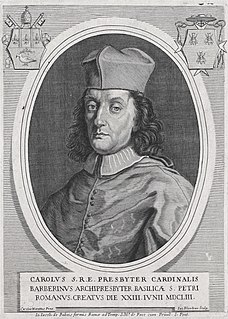
Carlo Barberini was an Italian Catholic cardinal and member of the Barberini family. He was the grand-nephew of Maffeo Barberini and son of Taddeo Barberini.

Giulio Gabrielli was an Italian Catholic cardinal. He is sometimes referred to as Giulio Gabrielli the Elder to distinguish him from Giulio Gabrielli the Younger.
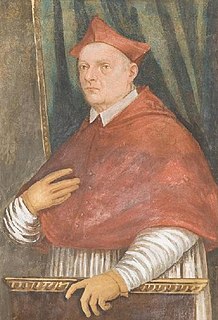
Marco Cornaro was an Italian Roman Catholic cardinal and bishop.

Francesco Gonzaga was an Italian nobleman, who was Duke of Ariano. He was also a Roman Catholic cardinal and bishop.

Marco Antonio Colonna (1523–1597) was an Italian Roman Catholic bishop and cardinal.
Pedro de Deza (1520–1600) was a Spanish Roman Catholic cardinal and bishop.
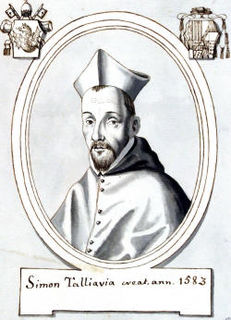
Simeone Tagliavia d'Aragonia (1550–1604) was a Sicilian cardinal and bishop.

Francesco Sforza (1562–1624) was an Italian cardinal and bishop.

The Papal inauguration of Pope Francis was held on 19 March 2013 in St. Peter's Square in the Vatican. Holy Mass was celebrated by Pope Francis before political and religious leaders from around the world. The crowd was estimated between 150,000 and 200,000. Official delegations from 132 states and various religious groups attended. It was the first papal inauguration attended by the Patriarch of Constantinople in over 1,000 years.


















